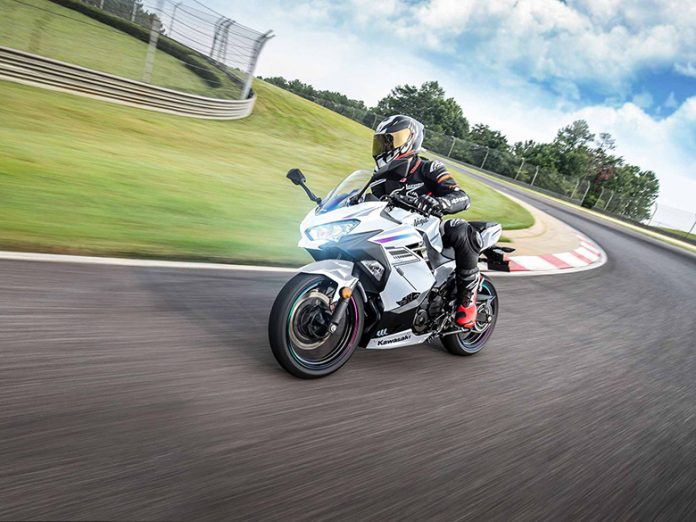With twin-cylinder engine complexity and the most significant displacement in its class (399cc), the 2023 Kawasaki Ninja 400 Sports Motorcycle delivers the most power. Setting a new standard for everyday sport riding, the bike’s accessible power, excellent ergonomics, and class-leading performance offer a smooth, controlled ride that appeals to experienced and novice riders. For motorcyclists who want to venture into the sports riding scene, the Ninja 400 is an excellent option due to its aggressive design, low seat height, and LED lighting.
With its lightweight trellis frame, uni-track rear suspension, twin LED headlights, 310 mm semi-floating petal front disc brakes, twin LED headlights, and high-quality multi-function dash instrumentation, 2023. The 2023 Kawasaki Ninja 400 Sports Motorcycle boasts a small twin 39-99 cc—cylinder engine with auxiliary and slipper clutch. Pearl Blizzard White / Metallic Carbon Grey, Metallic Magnetic Dark Gray / Metallic Matte Twilight Blue, and Metallic Carbon Gray / Metallic Matte Carbon Gray are the color options for the Ninja 400 and Ninja 400 ABS for 2023.
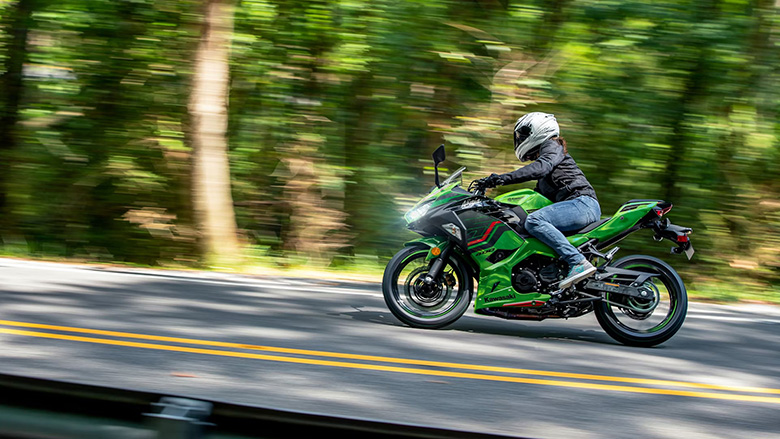
The 2023 Kawasaki Ninja 400 Sports Motorcycle is a lightweight sports bike designed for city use with track influences. With its large displacement engine, fresh, angular bodywork with LED headlights for sophisticated styling, and the Kawasaki Racing Team DNA of the only manufacturer that has currently won six consecutive FIM Superbike World Championships (2015-2020 ), the Ninja 400 has more power from its competitors in the lightweight sportbike market. As only a true ninja sportbike can do, every ride is exhilarating.
2023 Kawasaki Ninja 400 Sports Motorcycle – Features and Specs
Twin LED Headlamps
Slim LED headlamps (with low and high beams each, as well as LED position lighting) not only give the 2023 Kawasaki Ninja 400 Sports Motorcycle a more angular look but also significantly increase its brightness.
Powerful, Rider-Friendly Parallel Twin
The 2023 Kawasaki Ninja 400 Sports Motorcycle’s 399 cm3 engine offers a blend of controllability and performance. The engine delivers better performance and a satisfying sense of power at all rpm compared to its predecessor. An engine with a smooth and predictable response is easy to manage. Due to its efficient construction, the lightweight, compact engine is comparable in size to 250cc engines.
Also Read: Top Ten Best 400cc Motorcycles in the Philippines in 2023
High-Grade Cockpit
The 2023 Kawasaki Ninja 400 Sports Motorcycle features a large analog tachometer, a multi-function LCD screen, and a modern cockpit with warning LEDs on one side and gear position indicators on the other like in 2022 Kawasaki Ninja 400.
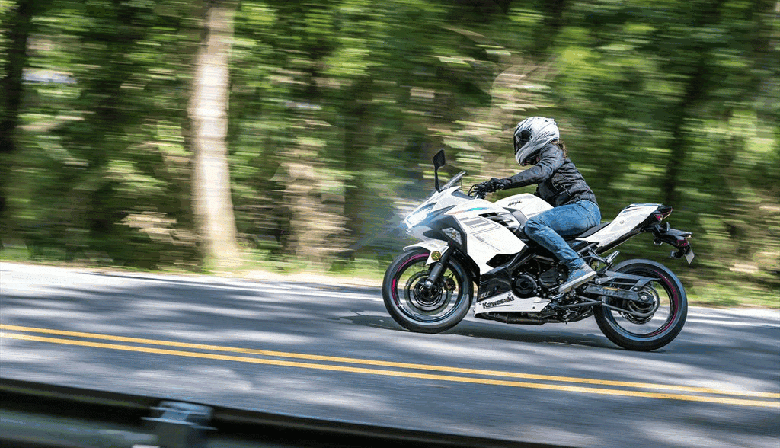
Most giant Brake Discs in Class
With a semi-floating front disc that provides reliable stopping power, the Ninja 400 features the same æ310 mm disc size as the Kawasaki Ninja ZZR1400. Brake contact is influenced by carefully selected brake line dimensions and materials. A stiffer new front brake master cylinder helps prevent inefficient (waste) strokes, aids control, and features the latest and lightest ABS unit from Nissin.
Relaxed, Sporty Riding Position
A comfortable rider triangle supports many rider sizes and riding conditions. The high handle position and slightly forward footpeg position keep the rider comfortable yet controllable, unlike some other models whose relatively radical riding stance sacrifices comfort.
ERGO-FIT
Thanks to the ERGO-FIT interface technology, different types of riders can feel at one with their machine. Some Ergo Fit modifications may require the purchase of genuine Kawasaki accessories.
Also Read: Top Ten Fastest 400cc Motorcycles in the World in 2023
Assist and Slipper Clutch
Assist and slipper Clutch is inspired from racing technology, the assist and sleeper clutch is a self-servo mechanism that facilitates a light clutch lever pull and acts as a back-torque limiter.
Economical ride measurement
The Economical Riding Indicator is a symbol that appears on the instrument panel to encourage fuel-efficient driving by indicating proper fuel consumption.
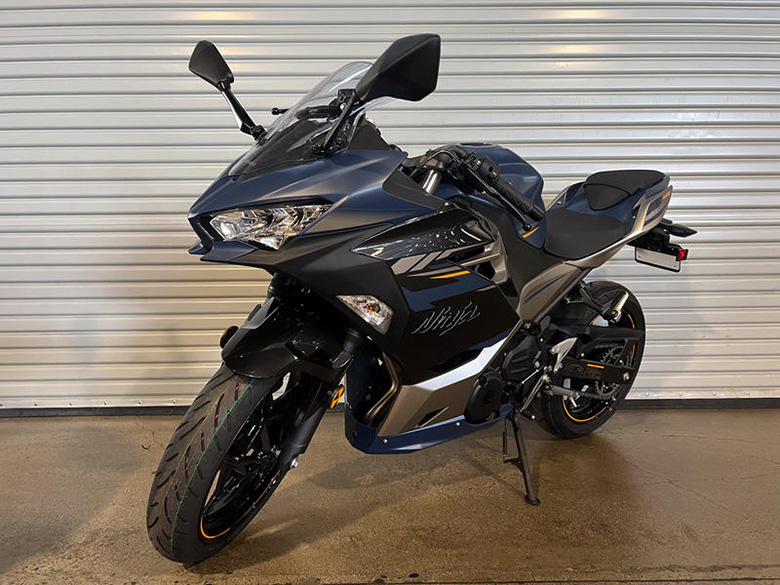
Engine
Novice and expert riders will enjoy the engine’s ride-friendly nature, smooth response, and low-end torque. A downdraft intake tract gives intake air a short, direct path into the cylinder, increasing filling efficiency and power, especially at high rpm. A larger airbox contributes to intake efficiency for more power.
Downdraft intake helps remove space behind the seat, allowing easier access to the ground. Thanks to the airbox design, the rider hears the engine’s intake tone more clearly. The uneven height of the intake funnels smoothes throttle response, eliminating torque dips.
The oval shape of the 32mm throttle valves, which causes them to open quickly after initial valve movement, helps contribute to faster throttle response. By placing fine atomizing injectors close to the throttle valves, gasoline can be sprayed directly onto the valves, improving throttle response and combustion efficiency. Performance is influenced by 23.5mm exhaust and 27.7mm intake valves at all engine rpm. Forged camshafts, usually limited to high-displacement machines, help reduce weight.
The lightweight design of the piston is made possible by oil jets cooling the underside of the piston. An aluminum die-cast cylinder with an open deck design provides better heat dissipation and reduces engine weight. A sleeveless cylinder that uses a plated bore.
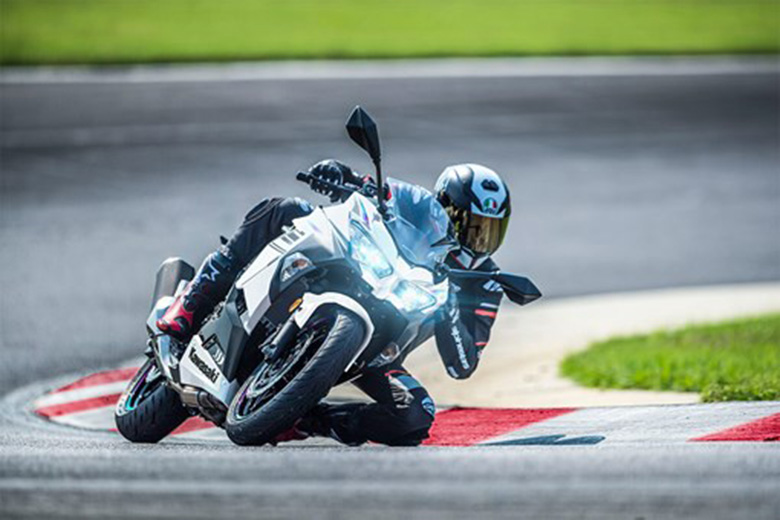
Tilting the cylinder forward reduces engine height by 20 degrees. Thanks to the lightweight flywheel, the engine can rev quickly, providing a direct power feel and crisp response. A machined balance shaft reduces engine vibration for a more comfortable ride. The shape of the oil pan reduces weight by enabling the exhaust system to follow a straight path.
Larger diameter header pipes improve performance throughout the rev range. The cooling system design minimizes weight and external coolant pipes. When riding in heavy city traffic, the radiator fan shroud helps increase comfort by directing hot air to the sides and away from the rider. To further improve comfort, it also keeps the frame, tank, and other areas where the rider comes in contact with cold.
The small operating plates of the assist and sleeper clutch (KP) feel very light when pulling the lever. During acceleration (assist function), the clutch is pressed together using the rotational forces of the clutch hub and pressure plate, allowing the use of shorter, lighter clutch springs for a lighter feel on the lever.
Transmission/Clutch
The small operating plates of the assist and sleeper clutch (KP) feel very light when pulling the lever. During acceleration (assist function), the clutch is pressed together using the rotational forces of the clutch hub and pressure plate, allowing the use of shorter, lighter clutch springs for a lighter feel on the lever.
The wide range of engagement contributes to ease of control. Closed gear ratios make shifting easier. The slipper function allows some clutch slippage under high back-torque conditions, such as when downshifting in a gear that is too low to prevent rear-wheel hop and engine lockup.
Lightweight Trellis Frame
The trellis frame’s design is reminiscent of the Kawasaki Ninja H2. Because of sophisticated dynamic stiffness analysis, the ensured maximum stiffness with minimum weight frame contributes to the bike’s overall low curb mass. The short supersport-style chassis’ wheelbase and long swingarm with a sharp steering angle allow for light and agile handling.
Suspension
The square tube swingarm structure reduces weight by providing stiffness without the need for unnecessary gusseting. The Uni-Trak (KP) rear suspension’s shock settings and linkage ratios enhance ride quality. The 41mm fork improves the front-wheel-mounted feel by providing stiffness and smooth suspension motion.
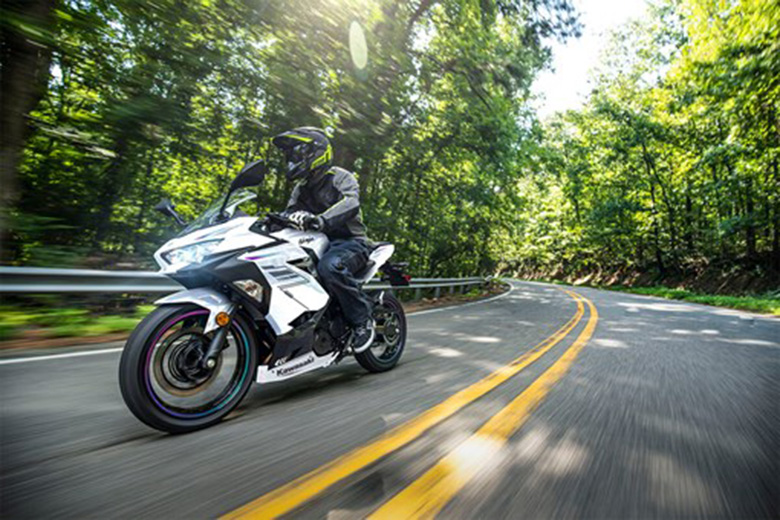
Brakes
A balanced actuation dual-piston caliper grips a large 310mm semi-floating petal front disc. The front brake disc is the same size as the Kawasaki Ninja ZX-14R, making it the largest in the class. For a more positive feel, a stiffer front brake master cylinder helps eliminate idle stroke. A 220mm rear petal disc is clamped by a rear dual-piston caliper with larger pistons.
Wheels and Tires
Stylish 5-spoke wheels with a star design reminiscent of the Ninja 650. They help save weight and improve handling by improving cornering performance due to their improved lateral stiffness. Radial tires are lighter, provide superior traction, and enhance ride comfort and agility.
Styling
Sharp front cowl with chin spoilers evokes images of Kawasaki supersport flagships Kawasaki Ninja H2 and Kawasaki Ninja ZX10R. Slim LED headlights improve an aggressive look, are more visible to other motorcycles, and provide more brightness than traditional bulbs. Large-volume bodywork helps make the Ninja 400 larger than an entry-class machine and more in line with the Ninja ZX-6R/Ninja ZX-10R.
The triple-pack design of the tail cowl, also found on the Ninja H2, further establishes the Ninja 400 lineage. The sleek look of the 2023 Kawasaki Ninja 400 Sports Motorcycle is completed with an LED tail light that resembles the styling of the Ninja ZX10R.
2023 Kawasaki Ninja 400 Sports Motorcycle – Price
The new 2023 Kawasaki Ninja 400 Sports Motorcycle is available for $5,699 to $5,899 only.
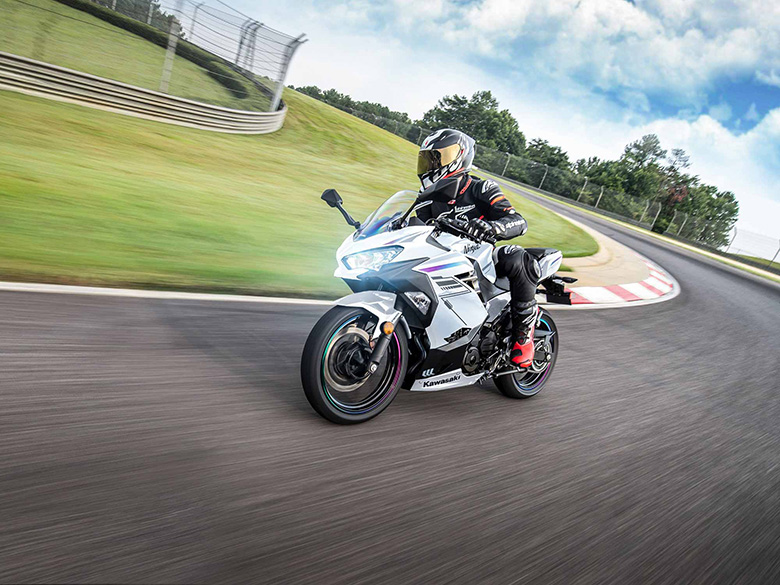
2023 Kawasaki Ninja 400 Sports Motorcycle – Technical Specifications
Engine
| Engine type | Liquid-cooled, 4-stroke Parallel Twin |
| Displacement | 399 cm³ |
| Bore x stroke | 70 x 51.8 mm |
| Compression ratio | 11.5:1 |
| Valve system | DOHC, eight valves |
| Fuel system | Fuel injection: Ø 32 mm x 2 |
| Starting System | Electric |
| Lubrication | Forced lubrication, wet sump |
Gear Performance & Transmission
| Maximum power | 33.4 kW {45 PS} / 10,000 rpm |
| CO2 emission | 91 g/km |
| Maximum torque | 37 N•m {3.8 kgf•m} / 8,000 rpm |
| Transmission | 6-speed |
| Final drive | Sealed chain |
| Primary Reduction Ratio | 2.219 (71/32) |
| Gear Ratios 1st | 2.929 (41/14) |
| Gear Ratios 2nd | 2.056 (37/18) |
| Gear Ratios 3rd | 1.619 (34/21) |
| Gear Ratios 4th | 1.333 (32/24) |
| Gear Ratios 5th | 1.154 (30/26) |
| Gear Ratios 6th | 1.037 (28/27) |
| Final reduction ratio | 2.929 (41/14) |
| Clutch | Wet multi-disc, manual |
Suspensions Brakes & Suspension
| Brakes, front | Single semi-floating 310 mm petal discs. Caliper: Single balanced actuation dual-piston |
| Brakes, rear | Single 220 mm petal disc. Caliper: Dual-piston |
| Suspension, front | 41mm telescopic fork |
| Suspension, rear | Bottom-Link Uni-Trak, gas-charged shock with adjustable preload |
Dimensions Frame & Dimensions
| Frame type | Trellis, high-tensile steel |
| Trail | 92 mm |
| Wheel travel front | 120 mm |
| Wheel travel rear | 130 mm |
| Tyre, front | 110/70R17 M/C 54H |
| Tyre, rear | 150/60R17 M/C 66H |
| L x W x H | 1,990 x 710 x 1,120 mm |
| Wheelbase | 1,370 mm |
| Ground clearance | 140 mm |
| Fuel capacity | 14 litres |
| Seat height | 785 mm |
| Curb mass | 168 kg |

